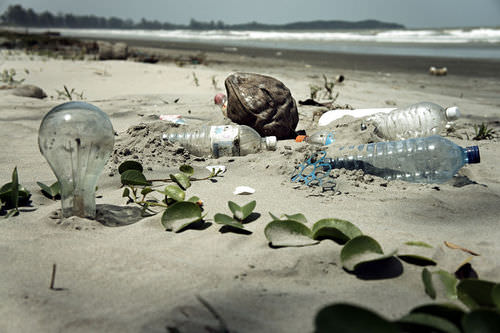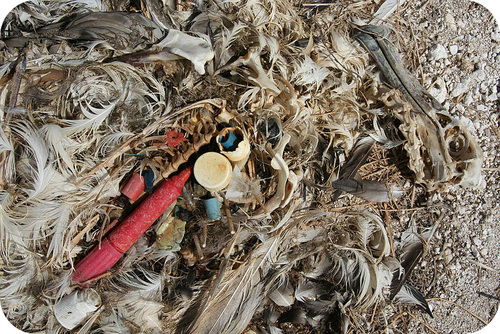9.10海洋垃圾补丁
章节大纲
-
Lesson
::经验教训How could these balloons kill a sea turtle?
::这些气球怎么会杀死海龟?Balloons flying off into the sky symbolize freedom and happiness. Eventually those balloons pop and the plastic falls to the surface. Much of this plastic will end up in the sea where it may be accidentally ingested by a marine organism — with dire results.
::气球飞向天空,象征着自由和幸福,最终这些气球和塑料掉到地上,许多塑料最终会落到海洋中,不小心被海洋生物吸收,结果非常可怕。Marine Trash
::海洋垃圾Trash from land may end up as trash in the ocean, sometimes extremely far from land. Some of it will eventually wash ashore, possibly far from where it originated ( Figure ).
::陆地垃圾可能最终成为海洋中的垃圾,有时离陆地极远。 有些垃圾最终会冲上岸,可能远离其起源地(图 ) 。Trash has washed up on this beach. Sources of Trash
::垃圾源源People once thought that the trash found at sea was mostly from ships, but it turns out that 80% is from land! Some of that is from runoff , some is blown from nearshore landfills, and some is dumped directly into the sea.
::人们曾经以为海上发现的垃圾大多来自船只,但结果却发现80%来自陆地。 有些来自径流,有些来自近海垃圾填埋场,有些直接倾倒到海里。Of the 20% of ocean trash that comes from ships at sea, about half is lines and nets from fishing vessels. Ghost nets can be lost accidentally or abandoned intentionally by fishers. These nets drift through the water and entangle animals so that they cannot escape. Other trash is thrown overboard from large vessels like cruise ships and container ships. Shipping containers sometimes go overboard in storms . Some noteworthy events, like a container of rubber ducks that entered the sea in 1992, are used to better understand ocean currents. The ducks went everywhere!
::在来自海上船只的20%的海洋垃圾中,约有一半是渔船的线路和渔网;渔夫可以不小心丢失或故意丢弃鬼网;这些渔网通过水和缠绕动物漂流,无法逃脱;其他垃圾被游轮和集装箱船等大型船只扔下船;运输集装箱有时在风暴中越洋;一些值得注意的事件,如1992年进入海洋的橡胶鸭集装箱,被用来更好地了解洋流;鸭子无处不在!Makeup of Trash
::垃圾堆的构成About 80% of the trash that ends up in the oceans is plastic. This is because a large amount of the trash produced since World War II is plastic. Also many types of plastic do not biodegrade, so they simply accumulate. While many types of plastic photodegrade — that is, they break up in sunlight — this process only works when the plastics are dry. Plastic trash in the water does break down into smaller pieces, eventually becoming molecule-sized polymers. Other trash in the oceans includes chemical sludge and materials that do biodegrade, like wood.
::海洋中80%的垃圾是塑料,这是因为自二战以来产生的大量垃圾是塑料,此外,许多类型的塑料不进行生物降解,因此它们只是积累。虽然许多类型的塑料光降解,也就是在阳光下分解,但只有在塑料干燥时才起作用。水中的塑料垃圾确实破碎成小块,最终成为分子大小的聚合物。海洋中的其他垃圾包括化学污泥和生物降解材料,如木材。Toxic chemicals
::有毒化学品Some plastics contain toxic chemicals, such as bisphenol A (BPA) which can alter hormone activity in humans and animals. Plastics can also absorb organic pollutants that may be floating in the water, such as the pesticide DDT (which is banned from agricultural use in many nations, but still used for malaria control).
::一些塑料含有有毒化学品,如二酚A(BPA),可以改变人类和动物的荷尔蒙活动;塑料也可以吸收可能漂浮在水中的有机污染物,如杀虫剂滴滴涕(在许多国家,杀虫剂滴滴涕被禁止用于农业用途,但仍用于疟疾控制)。Effect on Organisms
::对生物体的影响Marine birds, such as albatross, or animals like sea turtles, live most of their lives at sea and just come ashore to mate. These organisms can’t break down the plastic and they may eventually die ( Figure ). Boats may be affected. Plastic waste is estimated to kill 100,000 sea turtles and marine mammals annually, but exact numbers are unknown.
::海洋鸟类,比如信天翁,或者像海龟这样的动物,大部分生活在海上,只是上岸交配。 这些生物无法打破塑料,最终可能死亡(图 ) 。 船可能受到影响。 塑料废物估计每年会杀死10万只海龟和海洋哺乳动物,但确切数字未知。This albatross likely died from the plastic it had ingested. Plastic shopping bags are extremely abundant in the oceans. If an organism accidentally ingests one, it may clog digestion and cause starvation by stopping food from moving through or making the animal not feel hungry.
::塑料购物袋在海洋中极为丰富,如果一个有机体不小心吞食其中的有机体,它可能会阻断食物通过或使动物不感到饥饿,从而导致消化和饥饿。The Great Pacific Garbage Patch
::大太平洋垃圾场Trash from the lands all around the North Pacific is caught up in currents. The currents bring the trash into the center of the North Pacific Gyre . Scientists estimate that it takes about six years for trash to move from west coast of North America to the center of the gyre. The concentration of trash increases toward the center of the gyre.
::来自北太平洋各地土地的垃圾被潮流堵住了。海流将垃圾带入北太平洋热潮的中心。科学家估计,垃圾从北美西海岸移到环流中心需要六年左右的时间。垃圾的集中性将增加至环流中心。While recognizable pieces of garbage are visible, much of the trash is tiny plastic polymers that are invisible but can be detected in water samples. The particles are at or just below the surface within the gyre. Plastic confetti-like pieces are visible beneath the surface at the gyre’s center.
::虽然可识别的垃圾碎片是可见的,但大部分垃圾是微小的塑料聚合物,这些聚合物是看不见的,但在水样中可以检测到。 这些微粒位于或刚好位于陀螺旋内表层之下。 在陀螺中心的表面之下可以看到塑料式的蛋白质一样的碎块。Plastic bags in the ocean can be mistaken for food by an unsuspecting marine predator. Because the plastic in the North Pacific Gyre is so dispersed, it is difficult to estimate the total size of the garbage patch. However, most scientist estimate that it covers a surface area of about 1.6 million square kilometers (twice the size of the state of Texas), and that the total mass of the plastic is 80,000-100,000 metric tonnes.
::由于北太平洋Gyre的塑料分布如此分散,因此很难估计垃圾坑的总大小。 然而,大多数科学家估计,它覆盖面积约为160万平方公里(德克萨斯州面积的两倍 ) , 塑料总质量为80,000-100,000公吨。Effect on Organisms
::对生物体的影响In some areas, plastics have seven times the concentration of zooplankton . This means that filter feeders are ingesting a lot of plastics. This may kill the organisms or the plastics may remain in their bodies. They are then eaten by larger organisms that store the plastics and may eventually die. Fish may eat organisms that have eaten plastic and then be eaten by people. This also exposes humans to toxic chemicals that the fish may have ingested with the plastic.
::在某些区域,塑料的浓度是浮游动物的7倍,这意味着过滤器摄取了大量塑料,这可能杀死有机体或塑料可能留在体内,然后被储存塑料的较大有机体吃掉,最终可能死亡,鱼类可能食用食用已食用塑料的有机体,然后被人类食用。这也使人类暴露于有毒化学物质,而鱼类可能用塑料摄取有毒化学物质。There are similar patches of trash in the gyres of the North Atlantic and Indian oceans. The Southern Hemisphere has less trash buildup because less of the region is continent .
::北大西洋和印度洋的旋翼也有类似的垃圾残块,南半球的垃圾堆积较少,因为该区域大陆较少。Summary
::摘要- Trash from land (80%) or human activities at sea (20%) ends up in the oceans; about 80% of this trash is plastic.
::陆地垃圾(80%)或海上人类活动垃圾(20%)最终流入海洋;其中大约80%是塑料垃圾。
- Plastic trash does not usually biodegrade in the ocean but just forms tiny polymers that resemble plankton.
::塑料垃圾通常不会在海洋生物降解,而只是形成类似于浮游生物的微小聚合物。
- Plastic pieces of trash and plastic molecules can kill marine organisms by becoming lodged in their digestive systems or by trapping them so they can't swim.
::塑料垃圾和塑料分子的塑料碎片可以杀死海洋生物,因为它们会进入其消化系统,或把它们困住,从而无法游泳。
Review
::回顾- How can plastic kill marine organisms?
::塑料如何能杀死海洋生物?
- Since plastic doesn't biodegrade in the oceans, what does the future hold? What can be done to make the future better?
::既然塑料在海洋中不发生生物降解,未来会有什么结果?可以做些什么来改善未来?
- Some people say that the Great Pacific Garbage Patch is a hoax. What can scientists do to show people that it is real?
::有些人说大太平洋垃圾场是个骗局。 科学家能做些什么来向人们展示它的真实性呢?
- Trash from land (80%) or human activities at sea (20%) ends up in the oceans; about 80% of this trash is plastic.



